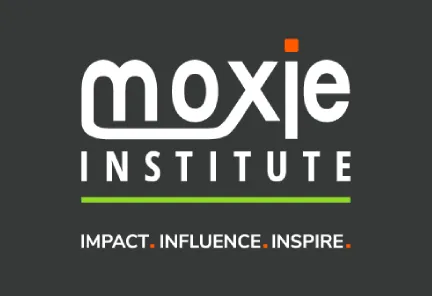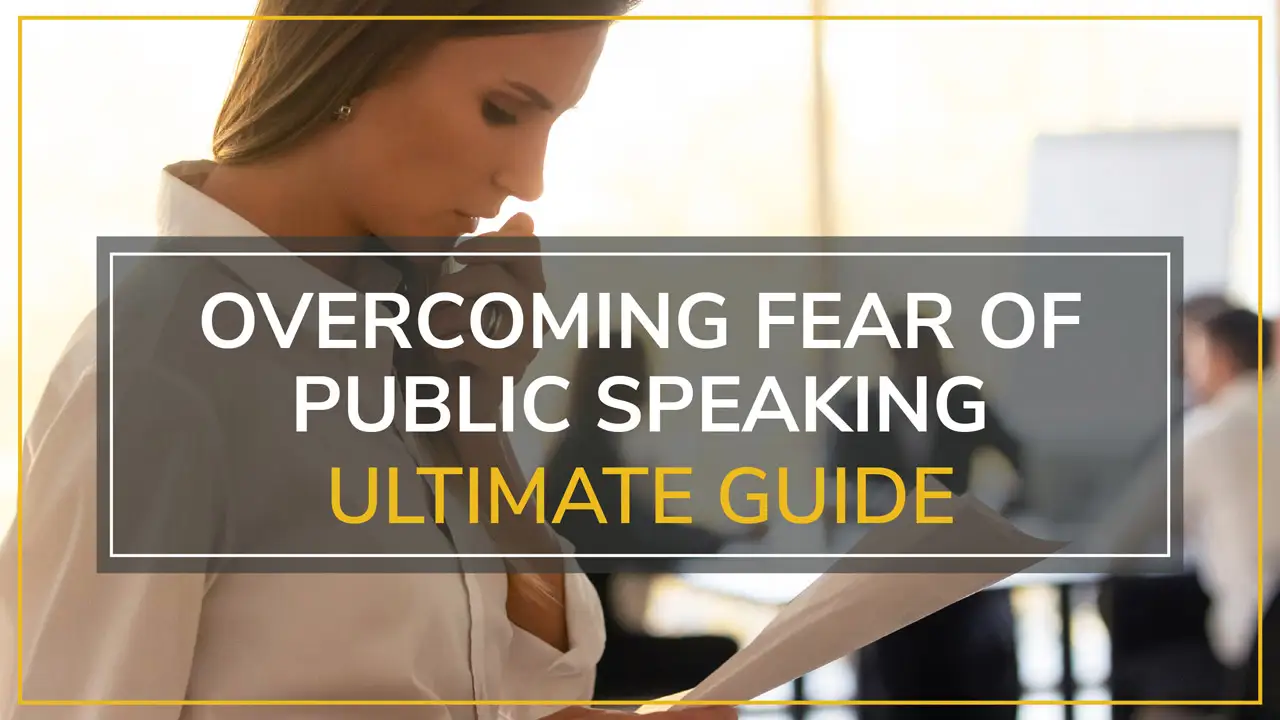Introduction: Why Traditional Stage Fright Advice Falls Short
Imagine this: You’re backstage and your heart’s pounding, you’re perspiring, and your mind’s going wild with worst-case scenarios. A well-intentioned friend taps you on the back with a big grin and says, “Go out there and picture everybody in their underwear!” Sound familiar? If that gives you a jolt, you’re not alone—and you’re about to find out how following this tired piece of advice has been preventing you from learning how to get over stage fright all along.
The conventional route for overcoming speech anxiety is to focus on the symptoms—not the underlying neurological and psychological factors. At Moxie Institute, from working with thousands of professionals over the years—everyone from Fortune 500 executives to TED speakers—we found that this ancient advice isn’t just unhelpful, but actually can make the sting of public speaking fear even worse.
Using our neuroscience-based methodology informed by performance psychology and adult learning theory, we’ve discovered what actually works when it comes to overcoming stage fright. The truth is much more encouraging than you might imagine: performance anxiety is not a character flaw or life sentence—it’s a controllable physiological response that can be converted into peak performance fuel.
In this extensive guide, we’re going to debunk those myths that are stopping you from moving forward, give you insight into what’s actually happening in your brain when you suffer from fear of public speaking, and arm you with the science-based tools that really work. You’ll learn how to leverage your nervous energy instead of wasting it, and you’ll discover why the most captivating speakers don’t eliminate that energy—they turn it to their advantage.
Eager to transform your relationship with stage fright? So let’s take a deep dive into what science actually tells us about getting over speaking anxiety for good.
The Neuroscience Behind Stage Fright: What's Really Happening in Your Brain
If you really want to know how to get over stage fright, it helps to know what’s really going on inside your brain once you step onto the stage. Your nervous system (contrary to how it might sometimes seem) is not broken—it’s functioning exactly the way it was designed to function, just not in a way that is helpful to your speaking goals.
The Physiological Reality of Speaking Anxiety
When you have speech anxiety, the primitive threat detection center in your brain—the amygdala—sees the speaking situation as a potential threat. Studies from Harvard Medical School suggest that this activates the fight-or-flight response our ancestors used when faced with physical threats.
In our experience coaching executives across industries, we’ve observed that this physiological response includes:
- Increased heart rate and rapid breathing
- Muscle tension, particularly in the throat and shoulders
- Heightened alertness and hypervigilance
- Release of stress hormones cortisol and adrenaline
- Narrowed attention focus, often called “tunnel vision”
Pro Insight: What a lot of people don’t know is that this response is very similar to what Olympic athletes experience before competition. The contrast is not an absence of arousal—it’s how they use and interpret it.
Why “Just Relax” Doesn’t Work
And this is where conventional wisdom breaks down. Telling someone with stage fright to “just relax” is like telling someone who is having an allergic reaction to “just stop being allergic.” According to the American Psychological Association, attempting to suppress physiological arousal often increases anxiety through what researchers call “ironic process theory.”
Through our work with high-stakes presenters, we’ve discovered that the most effective approach isn’t relaxation—it’s reappraisal. Instead of fighting your body’s natural response, you learn to reinterpret the sensations as preparation for peak performance.
Key Insight Summary:
- Stage fright is a normal physiological response, not a personal failing
- Your brain perceives speaking as a threat, triggering fight-or-flight
- Trying to relax often backfires due to ironic process theory
- The goal is reappraisal, not suppression
Debunking Common Stage Fright Myths
But before we go into what actually does work, let’s knock down a few of our most stubborn myths about overcoming public speaking fear. While it may be well-intentioned, outdated “tips” like these have been around for ages—despite literally no science behind them.
Myth 1: Imagine Your Audience in Their Underwear
This time-honored advice not only doesn’t work—it’s actually counterproductive. Research in Psychological Science demonstrates that visualization techniques work best when they’re realistic and empowering, not absurd and degrading.
In our executive coaching sessions, we’ve found that this advice:
- Creates cognitive dissonance by forcing unrealistic mental imagery
- Undermines respect for your audience, which is essential for authentic connection
- Increases self-consciousness rather than reducing it
- Distracts from your message and purpose
What Works Instead: Visualize your audience as intelligent, interested colleagues who want you to succeed. This aligns with reality and creates a collaborative rather than adversarial mindset.
Myth 2: Perfect Practice Makes Perfect
Many speakers believe that if they just rehearse enough times, their stage fright will disappear. This perfectionist approach often backfires spectacularly. Working with Fortune 500 leaders, we’ve observed that over-rehearsal can actually increase anxiety by:
- Creating unrealistic expectations for flawless delivery
- Making speakers more rigid and less adaptable
- Increasing the stakes for “perfect” performance
- Reducing spontaneity and authentic connection
What Research Shows: Studies in sports psychology reveal that moderate arousal actually enhances performance, while over-preparation can lead to “choking under pressure.”
Myth 3: Avoid Caffeine at All Costs
While it’s true that excessive caffeine can increase jitters, moderate amounts can actually enhance cognitive performance and focus. Research published in Psychopharmacology shows that 75-150mg of caffeine (roughly one cup of coffee) can improve attention and reduce mental fatigue.
Based on our work with thousands of speakers, the key factors are:
- Your individual caffeine tolerance
- Timing of consumption (avoid too close to speaking time)
- Combining with adequate hydration
- Understanding your personal response patterns
Reality Check: Many of our most confident clients maintain their normal caffeine routine on speaking days, finding that dramatic changes to their habits increase rather than decrease anxiety.
The Moxie Method: Science-Based Strategies That Actually Work
With the myths dispelled, let’s take a look at some of the research- and evidence-based strategies that will actually help you beat stage fright. Our approach, based on years of experience coaching top performers, blends neuroscience research with real-world application.
Cognitive Reframing Techniques
The foundation of our approach to conquering speech anxiety lies in cognitive reframing—literally changing how your brain interprets the physiological sensations of arousal.
The Excitement Relabeling Technique: Instead of saying “I’m nervous,” train yourself to say “I’m excited.” Harvard Business School research shows this simple shift can improve performance by up to 15% because excitement and anxiety share the same physiological markers—high arousal—but have different psychological implications.
Implementation Strategy:
- Notice the first signs of pre-speaking arousal
- Immediately label the sensation as “excitement”
- Connect the feeling to your message’s importance
- Remind yourself: “My body is preparing me to deliver something valuable”
Try This Now: The next time you feel your heart racing before any challenging situation, say out loud: “I’m excited about this opportunity.” Notice how this simple reframe shifts your mental state.
Performance Psychology Principles
Drawing from our work with elite performers, we apply the same psychological principles used by Olympic athletes and Broadway performers to help business professionals master their stage presence.
The Optimal Arousal Zone: Every speaker has a unique “optimal arousal zone”—a level of physiological activation that enhances rather than impairs performance. Through our coaching process, we help clients identify and cultivate this zone.
Characteristics of Optimal Arousal:
- Heightened focus without tunnel vision
- Physical energy without muscle tension
- Mental alertness without racing thoughts
- Confident posture and vocal projection
Advanced Technique – The Power Pose Protocol: Research from Columbia Business School demonstrates that specific body positions can influence hormone levels and confidence. Our modified protocol involves:
- Pre-speaking preparation: Stand with feet shoulder-width apart, hands on hips, chest open for 2 minutes
- Backstage moments: Raise arms in victory position for 30 seconds
- During presentation: Maintain upright posture with relaxed shoulders
Neuroscience-Based Preparation
Our preparation methodology leverages how the brain actually processes and recalls information under stress, rather than relying on rote memorization.
The Memory Palace Technique for Speakers: This ancient method, validated by modern neuroscience, helps you maintain access to your content even when experiencing public speaking anxiety.
Step-by-Step Implementation:
- Choose a familiar location (your home, office, or regular walking route)
- Identify 5-7 distinct locations along a logical path
- Associate each major section of your presentation with a specific location
- Create vivid, unusual mental images connecting your content to each spot
- Practice “walking” through your mental palace to retrieve information
Pro Tip from Our Coaches: The more unusual and emotionally engaging your mental images, the easier they are to recall under pressure. Don’t be afraid to make them humorous or dramatic.
Essential Insights:
- Reframe nervous energy as excitement and preparation
- Find your optimal arousal zone rather than seeking complete calm
- Use power poses to influence your physiology and confidence
- Prepare content using memory techniques that work under stress
Common Pitfalls That Sabotage Your Success

Even with the best intentions, many speakers fall into predictable traps that intensify rather than reduce their fear of speaking in public. In our coaching practice, we’ve identified these critical mistakes that can undermine your progress.
Pitfall #1: The Perfectionism Trap Many professionals believe they must eliminate all traces of nervousness to be effective speakers. This all-or-nothing thinking creates impossible standards and increases performance pressure.
Why it backfires: Perfectionism increases cortisol levels and creates what psychologists call “evaluation anxiety”—fear of being judged as inadequate.
The solution: Embrace “excellence over perfection.” Focus on delivering value to your audience rather than flawless execution. Some of the most memorable presentations include authentic moments of vulnerability or spontaneity.
Pitfall #2: Avoidance Reinforcement Declining speaking opportunities or delegating presentations to others provides short-term relief but strengthens long-term anxiety through negative reinforcement.
The research: Studies in behavioral psychology show that avoidance behaviors increase the brain’s perception of threat, making future speaking situations feel even more dangerous.
The breakthrough approach: Gradual exposure with proper support systems. Start with low-stakes speaking opportunities and progressively work toward more challenging situations.
Pitfall #3: Catastrophic Future Thinking Many speakers torture themselves with “what if” scenarios: “What if I forget my words? What if they ask a question I can’t answer? What if I embarrass myself?”
The neuroscience: This type of rumination activates the brain’s default mode network in ways that increase anxiety and reduce present-moment awareness.
Evidence-based intervention: Practice grounding techniques that anchor your attention in the present moment, such as the 5-4-3-2-1 sensory awareness technique.
Pitfall #4: Social Comparison Comparing yourself to polished, experienced speakers creates unrealistic benchmarks and undermines confidence.
What we’ve observed: Even seasoned executives fall into this trap, forgetting that every expert was once a beginner. This comparison often leads to imposter syndrome and self-sabotaging behaviors.
Healthier perspective: Focus on your unique message and authentic voice rather than trying to emulate others’ styles.
Pitfall #5: Physical Neglect Ignoring the physical aspects of speaking—breathing, posture, hydration, and energy management—leaves speakers vulnerable to physiological overwhelm.
The oversight: Many focus exclusively on content preparation while neglecting the physical performance aspects of public speaking.
Integrated approach: Treat speaking as a physical performance that requires attention to breathing, movement, vocal warm-ups, and energy management.
Critical Recovery Strategies:
- Replace perfectionist thinking with excellence-focused goals
- Use gradual exposure rather than avoidance to build confidence
- Practice present-moment awareness to counter catastrophic thinking
- Celebrate your unique voice instead of comparing to others
- Integrate physical preparation into your speaking routine
Advanced Techniques for High-Stakes Presentations
When the stakes are highest—board presentations, keynote addresses, media appearances—you need advanced strategies that go beyond basic anxiety management. These sophisticated techniques, developed through our work with C-suite executives and thought leaders, help you thrive under pressure.
The Spotlight Method
Traditional advice suggests reducing attention on yourself, but research reveals a counterintuitive truth: the most confident speakers actually increase their self-awareness in productive ways.
The Science: Studies in social psychology demonstrate that objective self-awareness—focusing on your behavior without emotional judgment—enhances performance and reduces anxiety.
Implementation Process:
- Pre-presentation audit: Conduct a neutral assessment of your physical state, energy level, and mental clarity
- Real-time monitoring: During your presentation, periodically notice your posture, breathing, and vocal quality without judgment
- Micro-adjustments: Make small, deliberate corrections to optimize your presence and delivery
Advanced Application: We teach our high-level clients to view themselves as both the performer and director, maintaining dual awareness that enhances rather than undermines their presence.
Embodied Confidence Training
This technique, borrowed from our performing arts methodology, helps you literally embody confidence through specific physical practices that influence your neurochemistry.
The Physiological Foundation: Your posture, breathing patterns, and movement directly influence neurotransmitter production and stress hormone levels. Research in embodied cognition shows that physical changes create measurable psychological shifts.
Core Techniques:
Diaphragmatic Dominance:
- Place one hand on chest, one on abdomen
- Breathe so only the lower hand moves
- Practice until this becomes automatic under stress
- Use this breathing during presentations to maintain calm authority
Vocal Sovereignty:
- Speak from your lower register rather than higher, stressed tones
- Project from your core rather than your throat
- Practice delivering key phrases with deliberate pacing
- Use strategic pauses to demonstrate control and confidence
Spatial Authority:
- Claim your full allotted space on stage
- Move with purpose rather than pacing nervously
- Use gestures that originate from your core
- Maintain an open, expansive posture
Professional Implementation Example: One Fortune 500 CEO we coached struggled with quarterly earnings calls until we implemented embodied confidence training. By mastering diaphragmatic breathing and vocal projection, he transformed from appearing defensive to projecting unshakeable authority—directly impacting investor confidence.
Try This Advanced Exercise: Record yourself delivering a 2-minute presentation while focusing entirely on your physical presence. Watch the recording and note the correlation between your physical confidence and vocal authority. Then repeat the exercise, implementing the embodied confidence techniques. The difference will be immediately apparent.
Mastery-Level Insights:
- Objective self-awareness enhances rather than undermines performance
- Physical changes create measurable psychological confidence shifts
- Advanced speakers become both performer and director simultaneously
- Embodied confidence techniques directly influence audience perception
Your Stage Fright Recovery Action Plan

Transforming your relationship with speech anxiety requires a systematic approach that builds skills progressively while respecting your nervous system’s learning process. This action plan, developed through our work with thousands of professionals, provides a clear roadmap for sustainable change.
Phase 1: Foundation Building (Week 1-2)
Daily Practice:
- 5 minutes of diaphragmatic breathing exercises
- Power pose routine before any challenging conversation
- Excitement relabeling whenever you notice arousal
- Record yourself delivering 2-minute impromptu presentations
Weekly Goal: Establish new neurological patterns for interpreting physiological arousal as preparation rather than threat.
Phase 2: Skill Integration (Week 3-4)
Core Activities:
- Practice the memory palace technique with short presentations
- Implement embodied confidence training in low-stakes situations
- Join a public speaking workshop or practice group
- Begin gradual exposure to speaking opportunities
Measurement: Notice decreased recovery time after speaking situations and increased willingness to volunteer for presentations.
Phase 3: Performance Optimization (Week 5-8)
Advanced Integration:
- Apply the spotlight method during actual presentations
- Develop your personal optimal arousal protocols
- Create contingency plans for high-pressure situations
- Schedule progressively challenging speaking opportunities
Professional Development: Consider working with a public speaking coach to accelerate your progress and refine advanced techniques.
Phase 4: Mastery Maintenance (Ongoing)
Sustaining Excellence:
- Regular practice in varied speaking contexts
- Continuous refinement of your personal methodology
- Mentoring others to reinforce your own learning
- Ongoing public speaking training to stay sharp
Critical Success Factors:
- Consistency matters more than intensity
- Track progress through objective measures, not just feelings
- Celebrate small wins to reinforce positive associations
- View setbacks as learning opportunities, not failures
Your 30-Day Quick-Start Protocol:
- Week 1: Master excitement relabeling and basic breathing techniques
- Week 2: Add power poses and begin memory palace practice
- Week 3: Start gradual exposure with supportive audiences
- Week 4: Integrate embodied confidence in real speaking situations
Professional Accelerator: For executives and leaders who need rapid transformation, our intensive executive communication coaching can compress this timeline while ensuring sustainable results.
Frequently Asked Questions
How long does it typically take to overcome stage fright?
The timeline for conquering public speaking fear varies significantly based on individual factors and the consistency of practice. Based on our experience coaching thousands of professionals, most people notice meaningful improvements within 2-4 weeks of implementing science-based techniques consistently. However, developing true mastery—where speaking feels energizing rather than draining—typically requires 2-3 months of deliberate practice.
The key factor isn’t time but quality of practice. Clients who work with our public speaking coaches often see accelerated progress because they’re implementing proven methodologies rather than trial-and-error approaches. Research in neuroplasticity shows that focused, deliberate practice creates lasting changes in brain structure and function more quickly than passive exposure alone.
Is it normal to still feel nervous even after years of speaking experience?
Absolutely. In our work with Fortune 500 executives and seasoned speakers, we’ve discovered that virtually everyone experiences some level of activation before important presentations. The difference is how experienced speakers interpret and channel this energy.
Research published in Current Directions in Psychological Science shows that optimal performance often occurs at moderate levels of physiological arousal. Elite speakers don’t eliminate nervousness—they transform it into focused energy and heightened presence. What changes isn’t the absence of sensation but your relationship with it.
What’s the difference between normal presentation nerves and clinical anxiety?
Normal presentation nerves are situation-specific, manageable with preparation, and don’t significantly impair your ability to function in other areas of life. They typically decrease as you begin speaking and gain momentum with your audience.
Clinical anxiety, however, may involve persistent, intrusive thoughts about speaking situations, physical symptoms that interfere with daily functioning, or avoidance behaviors that limit your professional opportunities. If your fear of public speaking significantly impacts your career advancement or quality of life, consider working with both a mental health professional and specialized presentation skills training to address both the clinical and performance aspects.
Can introverts be effective public speakers despite stage fright?
Definitely. Some of our most successful clients are introverts who initially believed their personality type was incompatible with public speaking. Introversion and social anxiety are different phenomena—many introverts are comfortable speaking once they’ve prepared thoroughly and understand their audience.
In fact, introverts often bring unique strengths to speaking: deeper preparation, thoughtful content development, and authentic connection with audiences. The key is developing presentation styles that honor your natural energy patterns rather than forcing extroverted approaches. Our coaching methodology helps introverted leaders leverage their authentic strengths while building confidence in speaking situations.
What should I do if I blank out or forget my speech during a presentation?
Having a recovery strategy prepared actually reduces the likelihood of blanking out because it eliminates the catastrophic fear of “what if I forget everything.” Here are the evidence-based recovery techniques we teach our clients:
The Bridge Technique: Prepare universal transition phrases like “This brings us to an important point…” that can connect any two sections of your presentation.
The Pause and Reset: Take a deliberate pause, make eye contact with a friendly face in the audience, take a deep breath, and continue with your next prepared point.
The Audience Engagement: Ask a relevant question to give yourself time to reorient: “How many of you have experienced this challenge?”
The Honest Recovery: Simply acknowledge the moment: “Let me pause for a moment to ensure I give you the most valuable information.” This humanizes you and often increases audience connection.
Does the “imagine your audience naked” advice ever actually work?
This classic advice is not only ineffective but can actually increase anxiety for most speakers. Research from the American Psychological Association shows that visualization techniques work best when they’re realistic and empowering, not absurd or demeaning.
The “naked audience” approach fails because it:
- Creates cognitive dissonance by forcing unrealistic imagery
- Undermines respect for your audience, which is essential for connection
- Increases self-consciousness rather than reducing it
- Distracts from your message and purpose
Instead, visualize your audience as intelligent colleagues who want you to succeed. This aligns with reality and creates a collaborative rather than adversarial mindset.
How can I manage physical symptoms like shaking or sweating during presentations?
Physical symptoms are your body’s natural response to activation, and trying to suppress them often makes them worse. Here’s our evidence-based approach:
For Trembling: Focus on grounding techniques—feel your feet on the floor, hold the podium or use deliberate gestures to channel the energy productively.
For Sweating: Dress in layers you can remove if needed, use antiperspirant specifically designed for stress sweating, and remember that audiences rarely notice what speakers think is obvious.
For Voice Shaking: Practice diaphragmatic breathing, speak slightly slower than feels natural, and use your lower vocal register rather than higher, tenser tones.
Universal Approach: The embodied confidence techniques we teach help you work with your physiology rather than against it. Many clients find that accepting and channeling physical activation actually enhances their presence and energy.
Should I avoid caffeine before speaking?
This depends entirely on your individual response patterns and caffeine tolerance. Research in psychopharmacology shows that moderate caffeine consumption (75-150mg, roughly one cup of coffee) can actually improve cognitive performance and focus for most people.
In our coaching practice, we’ve found that dramatically changing your routine on speaking days often increases rather than decreases anxiety. If you normally drink coffee, maintain that routine. If you’re caffeine-sensitive, stick with your usual patterns. The key is avoiding excessive amounts and timing consumption appropriately—generally not within 30 minutes of speaking.
What’s the most effective way to practice overcoming stage fright?
The most effective practice combines gradual exposure with skill building in supportive environments. Start with low-stakes speaking opportunities—team meetings, volunteer organizations, or public speaking workshops —while simultaneously developing the cognitive and physical techniques we’ve discussed.
Progressive Exposure Protocol:
- Begin with prepared remarks to small, familiar groups
- Progress to impromptu speaking in comfortable settings
- Advance to formal presentations with supportive audiences
- Challenge yourself with higher-stakes or larger audiences
- Seek feedback and continuous improvement opportunities
Working with a qualified public speaking coach can accelerate this process by providing structured progression, immediate feedback, and personalized strategies based on your specific challenges and goals.
How do I know if I need professional help for my speaking anxiety?
Consider professional support if your fear of speaking in public significantly impacts your career advancement, causes persistent distress outside of speaking situations, or if you’ve tried self-help approaches without success. Professional presentation skills training can provide structured skill development, while mental health professionals can address underlying anxiety patterns.
Many of our most successful clients combine both approaches—working with specialized speaking coaches for skill development while addressing broader anxiety patterns with qualified therapists. This integrated approach often produces the most sustainable and comprehensive results.
TAKE THE FIRST STEP TO MASTER POWERFUL NEW SKILLS
Schedule an easy 30-minute call using our using our calendar. We’re here to help!









